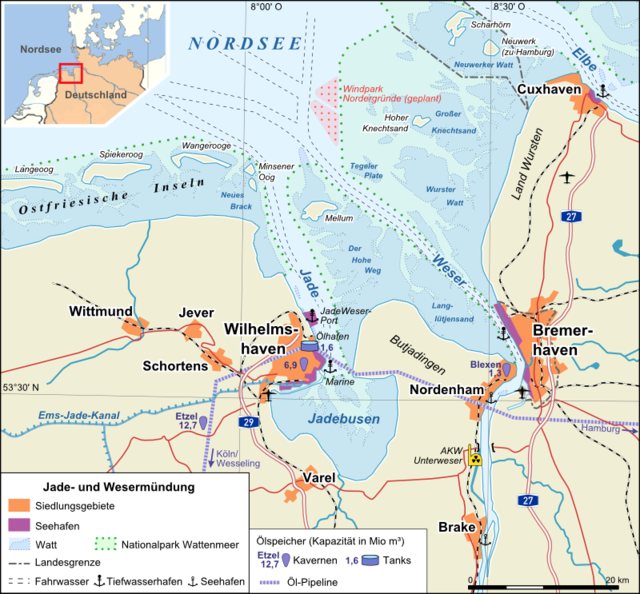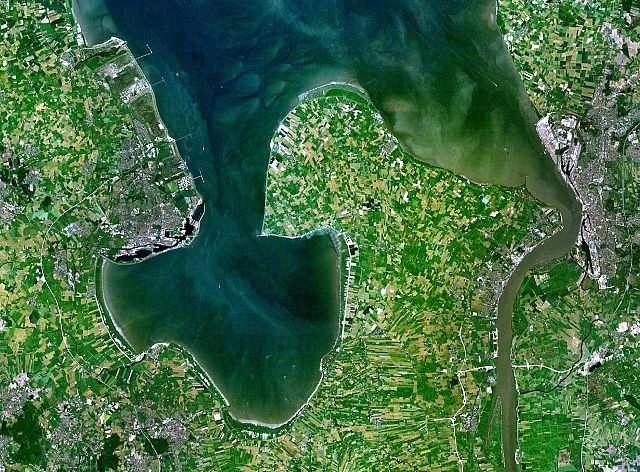Jade Bight
Bay on Germany's North Sea coast From Wikipedia, the free encyclopedia
Bay on Germany's North Sea coast From Wikipedia, the free encyclopedia
The Jade Bight,[1][2] also known as Jade Bay;[3] German: Jadebusen) is a bight or bay on the North Sea coast of Germany. It was formerly known simply as (the) Jade or Jahde. Because of the very low input of freshwater, it is classified as a bay rather than an estuary.[4]



About 180 km² (70 mi²) in area, the Jade was largely created by storm floods during the 13th and 16th centuries.[5] Since the early 14th century, it has joined eastward to the estuary of the river Weser. For some time, there were three permanent connecting branches and one flood bed between the river and the bight, forming an estuarine delta. The first of these junctions was closed in 1450 by dikes and the last one in 1515. However, about a century passed before most of the area flooded by these connections was regained for pasture and arable land.
In the west, the Jade extended far into the Frisian peninsula. From the early 16th century, a number of dikes were built against the storm floods and to gain arable land. The main dike, Ellenser Damm, was built between 1596 and 1615 by the County of Oldenburg before the agreement with the objecting County of East Frisia was finished successfully.
The extension of Jade Bight and its branches fragmented the free Frisian territory of Rüstringen in Bant in the northwest, most of which has disappeared in the waves, Bovenjadingen ('above the Jade') with the low moraine hills of Friesische Wehde in the southwest, Butjadingen ('outside the Jade') in the northeast, which was an island for almost two centuries, and Stadland ('bank-land'), which became a narrow island along the left bank of the Weser in 1384. The devastation by floods and the losses of land weakened the Frisian community. In the years about 1400, the Free City of Bremen tried to rule Stadland and Butjadingen. At the beginning of 16th century, all countries around Jade Bight were conquered by the Counts of Oldenburg.
Together with the conquest of the island of Stadland, the Lockfleth, the largest branch of the Weser delta, was interrupted by a dike at Ovelgönne in 1515. In the next years the water course was cut off at more sites. The most important projects prior to 1650 were the Ellenser Damm across the Schwarzes Brack in the west of the bay in 1596 to 1615 and the New Hoben-Dike in the east in 1643. South of this dike, the coast became a mossy bog. The bog was affected by high floods, and dikes built on the bog proved to be very fragile.
Tidal flows make the neck of Jade Bight the deepest natural channel near Germany's North Sea coast. In 1853, the Kingdom of Prussia bought a part of the western shore of the bay from Oldenburg, in order to use the harbour as a Prussian naval base, later called Wilhelmshaven. During World War I, the German High Seas Fleet (Hochseeflotte), the main battle fleet of the Imperial German Navy (Kaiserliche Marine), was based at Wilhelmshaven in the Jade Bight. After World War II, Wilhelmshaven became the main German port for the import of petroleum.
The foreshore areas of Jade Bight form a part of the German Wadden Sea National Parks.

Seamless Wikipedia browsing. On steroids.
Every time you click a link to Wikipedia, Wiktionary or Wikiquote in your browser's search results, it will show the modern Wikiwand interface.
Wikiwand extension is a five stars, simple, with minimum permission required to keep your browsing private, safe and transparent.